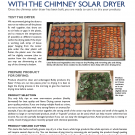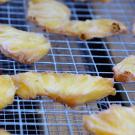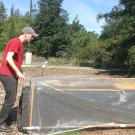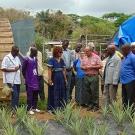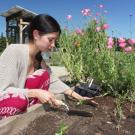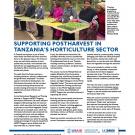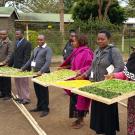The chimney solar dryer is built with low-cost materials and combines heat collection with constant airflow for efficient drying. Designed by UC Davis researchers for the Horticulture Innovation Lab, the dryer allows farmers and others to use the sun to efficiently dry fruits, vegetables and other foods for long-term storage. Farmers can add value to crop surpluses and extend access to fruits and vegetables throughout the year.
How does the chimney solar dryer work?
The chimney solar dryer combines solar heat collection with rapid air flow for efficient drying of fresh produce.
The chimney on this solar dryer ensures continuous air flow around the product, thus increasing the speed of drying compared to other designs. This design’s large heat-collection area (the drying table) ensures high temperatures and rapid water removal. Furthermore, the design is flexible to allow users to modify tray depth and size to fit local demands.
Building a chimney solar dryer
There are four main components of a chimney solar dryer:
- a drying table covered with black material
- a chimney covered with clear plastic
- mesh drying trays to hold the produce
- clear polyethylene film that covers the trays and drying table and is sealed to the chimney.
Materials to build the chimney solar dryer include wood pieces, wood or bamboo poles, clear polyethylene (greenhouse-grade plastic), black plastic or black fabric, and food-grade mesh. The dryer dimensions can be changed to meet specific needs. The dryer should be built in a flat area with good sun exposure available for the entire dryer.
Drying fruits and vegetables with a chimney solar dryer
Once you have built a chimney solar dryer, you will want to test the dryer to make sure it is working well and that there are no leaks or gaps in the plastic.
Thin items like herbs and leafy greens may dry in a few hours, while large products like whole apricots or whole bananas will require several days to dry. You can decrease drying time by removing pits, peeling the product, and/or cutting it into thin slices.
The manual includes considerations for placing the product in the chimney solar dryer and conditions that will affect performance of the dryer.
Designing the chimney solar dryer
Michael Reid and James Thompson, UC Cooperative Extension specialists with UC Davis, designed the chimney solar dryer initially for a solar dryer contest. Researchers with the Horticulture Innovation Lab have built and used versions of the chimney solar dryer with farmers in the United States, Ghana, Guinea, Kenya, Tanzania, Bangladesh, Thailand, Guatemala and Honduras.



